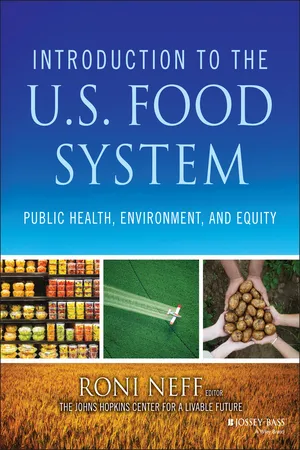
- English
- ePUB (mobile friendly)
- Available on iOS & Android
About this book
Introduction to the US Food System: Public Health, Environment, and Equity is a comprehensive and engaging textbook that offers students an overview of today's US food system, with particular focus on the food system's interrelationships with public health, the environment, equity, and society. Using a classroom-friendly approach, the text covers the core content of the food system and provides evidence-based perspectives reflecting the tremendous breadth of issues and ideas important to understanding today's US food system. The book is rich with illustrative examples, case studies, activities, and discussion questions.
The textbook is a project of the Johns Hopkins Center for a Livable Future (CLF), and builds upon the Center's educational mission to examine the complex interrelationships between diet, food production, environment, and human health to advance an ecological perspective in reducing threats to the health of the public, and to promote policies that protect health, the global environment, and the ability to sustain life for future generations.
Issues covered in Introduction to the US Food System include food insecurity, social justice, community and worker health concerns, food marketing, nutrition, resource depletion, and ecological degradation.
- Presents concepts on the foundations of the US food system, crop production, food system economics, processing and packaging, consumption and overconsumption, and the environmental impacts of food
- Examines the political factors that influence food and how it is produced
- Ideal for students and professionals in many fields, including public health, nutritional science, nursing, medicine, environment, policy, business, and social science, among others
Introduction to the US Food System presents a broad view of today's US food system in all its complexity and provides opportunities for students to examine the food system's stickiest problems and think critically about solutions.
Frequently asked questions
- Essential is ideal for learners and professionals who enjoy exploring a wide range of subjects. Access the Essential Library with 800,000+ trusted titles and best-sellers across business, personal growth, and the humanities. Includes unlimited reading time and Standard Read Aloud voice.
- Complete: Perfect for advanced learners and researchers needing full, unrestricted access. Unlock 1.4M+ books across hundreds of subjects, including academic and specialized titles. The Complete Plan also includes advanced features like Premium Read Aloud and Research Assistant.
Please note we cannot support devices running on iOS 13 and Android 7 or earlier. Learn more about using the app.
Information
Chapter 1
Food Systems

Learning Objectives
- Explain a systems approach to food systems.
- Describe a public health approach to assessing food systems.
- Provide a broad overview of the US food system, including its key dimensions, components, and challenges.
- Discuss different approaches to food system change, including public health and human rights, and provide examples of changes underway.
- Where did the food originate, how was it processed, and how did it get to you?
- How much did it cost, where did the money go, and why?
- How healthy was it?
- How did producing it affect the environment? Workers? Animals?
- Why did you choose it?
THE FOOD SYSTEM AS A SYSTEM
system
food system
subsystems

inputs
Table of contents
- Cover
- Title Page
- Copyright
- List of Figures and Tables
- Dedication
- Introduction
- Acknowledgments
- About the Editor
- Author Affiliations
- About the Center for a Livable Future
- Chapter 1: Food Systems
- Part 1: Outcomes
- Part 2: Drivers of the Food System
- Part 3: Food Supply Chain: From Seed to Sales
- Part 4: Food in Communities and on Tables
- Glossary
- Photo Credits
- Index
- End User License Agreement